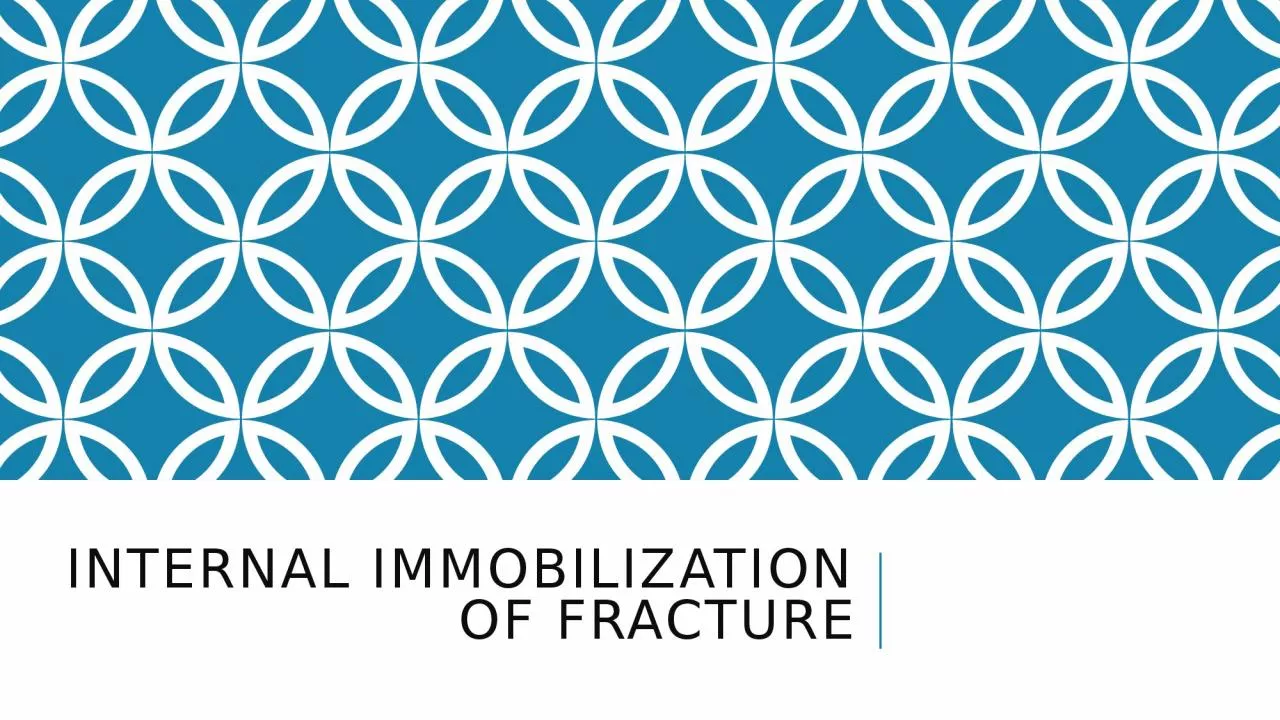

INTERNAL IMMOBILIZATION Intramedullary pinning and nailing Rush pins Cross pinning Wires Screws Transfixation Hanging pin cast Plate fixation Steinmann pins INTRAMEDULLARY PINNING AND NAILING ID: 918058
Download Presentation The PPT/PDF document "Internal immobilization of fracture" is the property of its rightful owner. Permission is granted to download and print the materials on this web site for personal, non-commercial use only, and to display it on your personal computer provided you do not modify the materials and that you retain all copyright notices contained in the materials. By downloading content from our website, you accept the terms of this agreement.
Slide1
Internal immobilization of fracture
Slide2INTERNAL IMMOBILIZATION
Intramedullary pinning and nailing
Rush pins Cross pinning Wires Screws Transfixation Hanging pin cast Plate fixation
Steinmann pins
Slide3INTRAMEDULLARY PINNING AND NAILING
Sound and economical method of internal fixation
Steinmann pins, Kuntscher nail (K-nail) is used for repair of long bone fractures in large as well as in small animal A pin should provide 3 point fixation
Slide4CONT.
Pin provides axial alignment and stability, but little rotational stability
A pin should cover approx. 60-70% of diameter of medullary cavity Fracture of Radius, Tibia, Humerus and Femur can be repaired by this method Success rate of this method in large animals depends upon the size and weight of animal Two or more pins (stack pinning) can be used in adult animals especially in femur and humerus Failure are related to mechanical factors such as
Pin migration
Bending
loosening
Slide5Cont.
Pin is inserted in the medullary cavity by using a simple hand driven chuck
Pin can be inserted via 2 routes :-Retrograde : within the fracture siteNormograde : from one end of the boneNormograde Retrograde
Slide6RUSH PIN
Used to treat fractures of the distal femur and supracondylar and
diaphyseal fractures of tibia A rush pin is tempered round intramedullary device It has hooked end that is used to drive and seat the pin into the bone Other end is tapered which bounces off the inner cortex as it is inserted into the medullary cavity of bone Elastic bending nature of pins produces a spring like action to provide rigid fixation Generally inserted from distal end of bone
Placement of rush pin
Slide7CROSS PINNING
Useful in compound
subarticular fractures of long bones Especially tibia, metacarpus and metatarsus Can also be used to repair fracture of mandible
Slide8WIRES
In orthopaedic surgery different types of wire are used The rigid kirschner wire, The flexible orthopaedic wire Suture wire.
kirschner
wire
Orthopaedic
wire
Suture wire
Slide9Orthopaedic
wire
It is a monofilament soft and flexible wire.Full circlage: The wire should be fixed perpendicular to the long axis of the bone and the knot must be twisted down snugly. Hemicirclage: Hemiciriclage wiring is effective in reinforcing longitudinal cracks in the cortex & prevent rotation and overriding of oblique fracture fragments
Tension band wiring or figure of ‘8’ wiring :
used in conjunction with Steinmann pins to achieve stable internal fixation by opposing the pull of muscular attachment on bone.
Kirschner
wire:
Kischner
wires are used for temporary fixation of fragments, tension band
osteosynthesis
and intramedullary fixation in small bones.
Full
circlage
Hemicirclage
Tension band wiring
Slide10Slide11Slide12screws
CorticalThese screws are full threaded and used where cortical bone predominatesThe inter-fragmentary compression is accomplished by drilling a long gliding hole (oversized hole) in the near cortex and a smaller threaded hole in the far cortex. Cancellous
The screws
are partially threaded
used in
cancellous
bone
e.g. fracture of the olecranon, slab, fractures of the metacarpus and metatarsus, condylar fractures and longitudinal fracture of the phalanx can be fixed with
screw.
Oblique
fracture of long bones can also be fixed by application of screw in combination with internal or external support
.
Cortical
Screws
Cancellous
Screws
Slide13Transfixation
Most useful for treatment of
diaphyseal fracture of the radius and tibia. A minimum of two intramedullary pins in each fractured fragment are inserted transverselyThe protruding ends of intramedullary pins are fixed in position by connecting external bars and protected with caps. The pins are connected by one or more connecting bars. The assembly should be removed only after complete union of fractured
fragments
Transfixation
pins
Slide14Slide15Complication:
Soft tissue infection,
Bone necrosis, Periosteal reaction around the transverse pins. Pathological fracture may occur at the point of insertion of transverse pins.
Slide16Hanging
pin Cast
Only one pin is inserted tissue transversely through the proximal fragment . This technique has the advantage of preventing rotation of the fractured bone & downward slipping of the plaster cast.
Slide17Plate fixation
Plate
provide axial compression, counteract rotational forces, can effectively immobilize oblique and comminuted fracture. Plate classification: ( according to the
function)
Compression plate: Static compression (a transverse or short oblique fracture can be best treated by compression plate
Neutralization
Plate:
Splinting
and lag screw fixation (
comminuted
fracture are anatomically reconstructed).
Buttress Plate:
Splinting or bridging a fracture area with buttress of the main fragments
.
Buttress
Plate
Neutralization
Plate
Slide18Dynamic compression plate (
DCP
) DCP is used for compression and stabilization of a fracture. Compression is achieved by tightening the screw inserted in a specially designed hole in the plate. There are three sizes of DCP used in small animal surgery (2.7 mm, 3.5mm and
4.5 mm).
At least 3 cortical screw on each side of the fracture fragment should be used.
Slide19SCAPULAR FRACTURE
May occur through the body, spine, acromion, neck,
supraglenoid tuberosity and glenoid cavityUncommon in dogs and cats bcoz large muscles surrounding scapula protect it from direct injuryCommon concurrent injuries include :Thoracic injuriesPulmonary contusionsRib fractureNerve injury
Slide20DIAGNOSIS
History
Physical examination : Non weight bearing lameness, Swelling over scapula, crepitation on palpation Diagnostic imaging : Radiographs of scapula should include Lateral viewCaudocranial view
Slide21SURGICAL TREATMENT
Fixation systems applicable for scapular fracture includes
Plates and screws , Orthopaedic wires and Kirschner wiresUse of crossed krischner wire
Use of Plating (B) and Orthopaedic wires (D) to repair transverse fracture